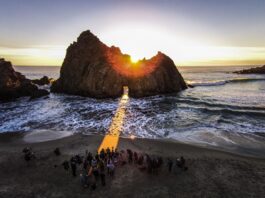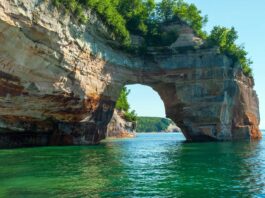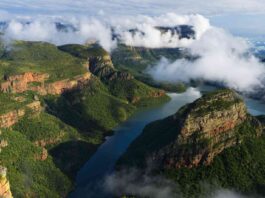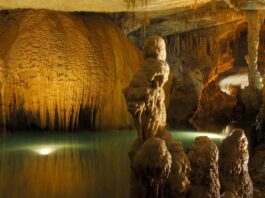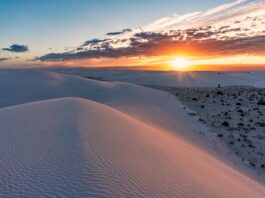Canyonlands National Park, located in southeastern Utah, USA, is a stunning and expansive landscape characterized by deep canyons, towering mesas, and dramatic arches. Established in 1964, the park covers over 337,000 acres and is divided into four distinct districts: Island in the Sky, The Needles, The Maze, and the Colorado and Green Rivers. Each district offers unique geological formations, diverse ecosystems, and opportunities for outdoor recreation.

Introduction to The Needles District:
The Needles district is one of the four main districts within Canyonlands National Park and is renowned for its colorful spires, rock formations, and a vast network of hiking trails. This district, situated in the southeastern part of the park, earned its name from the towering red and white rock pinnacles that resemble needles.


Significance and Unique Features:
- Colorful Rock Formations: The Needles district is celebrated for its striking and diverse rock formations, including red and white banded spires, arches, and natural bridges. The colors of the rocks are particularly vibrant during sunrise and sunset, creating a mesmerizing landscape.
- Hiking Trails: The Needles offers an extensive network of hiking trails, catering to both novice and experienced hikers. Popular trails include the Chesler Park Loop, Elephant Hill, and the Joint Trail. These trails showcase the unique geology of the area and provide breathtaking views of the surrounding canyons.
- Ancient Puebloan Ruins: The Needles district is home to remnants of ancient Puebloan culture, including well-preserved granaries, pictographs, and petroglyphs. These archaeological sites offer a glimpse into the lives of the indigenous people who once inhabited the region.
- Solitude and Wilderness: Compared to other districts in Canyonlands, The Needles is often considered less crowded, providing visitors with a sense of solitude and a more immersive experience in the rugged wilderness. The vast expanses of open space and the absence of large crowds contribute to the district’s serene atmosphere.
- Dark Skies: Canyonlands National Park, including The Needles, is designated as an International Dark Sky Park. This recognition highlights the exceptional quality of the park’s night skies, offering stargazers unparalleled opportunities to observe celestial wonders due to minimal light pollution.
In conclusion, The Needles district in Canyonlands National Park stands out for its breathtaking landscapes, unique geological features, ancient cultural history, and opportunities for outdoor adventure, making it a must-visit destination for nature enthusiasts and those seeking an unforgettable desert experience.
Geological Formation of The Needles

The Needles district in Canyonlands National Park is a testament to the complex and dynamic geological processes that have shaped the landscape over millions of years. The unique rock formations in this region are the result of a combination of sedimentation, erosion, and tectonic activity.
1. Sedimentation:
- The geological history of The Needles dates back to the Late Permian and Early Triassic periods, around 300 to 200 million years ago. During this time, the area was covered by a vast inland sea.
- Over millions of years, sediments such as sand, silt, and mud accumulated at the bottom of the sea, forming thick layers of sedimentary rock. The compression of these sediments eventually led to the creation of rock layers.
2. Tectonic Activity:
- The uplifting of the Colorado Plateau, caused by tectonic forces, played a crucial role in shaping The Needles. Around 20 million years ago, tectonic uplift and the erosion of overlying rocks exposed the ancient sedimentary layers.
3. Erosion:
- Erosion, primarily driven by the Colorado River and its tributaries, gradually carved through the exposed rock layers, creating the intricate canyons and spires seen in The Needles today.
- The erosional processes are ongoing, continually sculpting the landscape and exposing new rock formations. Freeze-thaw cycles, wind erosion, and occasional flash floods contribute to the dynamic nature of the terrain.

Unique Rock Formations:
- Spires and Pinnacles: The most distinctive feature of The Needles is its towering rock spires and pinnacles, which are composed of the Cedar Mesa Sandstone. These formations often have a vertical, needle-like appearance, hence the name of the district.
- Cross-Bedding: The rock layers in The Needles exhibit remarkable cross-bedding, visible as diagonal layers within the sandstone. This feature reflects the ancient dune environments where the sand was deposited.
- Natural Arches and Bridges: Erosion has sculpted natural arches and bridges, creating iconic formations like Elephant Hill and the Joint Trail. These arches are formed as softer rock layers erode beneath a more resistant layer, eventually creating openings.

Geological History and Context:
- Ancient Environments: The sedimentary rocks in The Needles bear witness to ancient environments, from marine settings during the Permian and Triassic periods to the desert dune environments of the Jurassic period.
- Uplift and Erosion: The uplift of the Colorado Plateau and the subsequent erosion by the Colorado River and its tributaries have been instrumental in exposing the layered rock formations and shaping the intricate canyons.
- Tectonic Evolution: The geological history of The Needles is intricately tied to the tectonic evolution of the region, with uplift and subsidence influencing the deposition and exposure of rock layers.
In summary, The Needles’ geological formations are a result of a complex interplay of sedimentation, tectonic forces, and erosional processes over millions of years. The resulting landscape showcases the enduring forces of nature and provides a remarkable canvas for geological enthusiasts and visitors alike.
Cultural and Historical Significance

The Needles district in Canyonlands National Park holds cultural and historical significance, primarily due to the presence of ancient Puebloan archaeological sites and the area’s connection to indigenous cultures. The cultural and historical importance of The Needles can be understood through the following points:
- Ancient Puebloan Presence:
- The Needles district is home to well-preserved archaeological sites left behind by the ancient Puebloan people, also known as Ancestral Puebloans or Anasazi.
- Ruins of granaries, dwellings, and other structures can be found throughout the region, providing insight into the daily lives, social structures, and cultural practices of these indigenous people.
- Rock Art and Petroglyphs:
- The canyon walls in The Needles feature numerous examples of rock art, including petroglyphs and pictographs. These intricate drawings and carvings depict various aspects of Puebloan life, such as hunting scenes, religious rituals, and symbolic imagery.
- Cultural Landscape:
- The landscape of The Needles itself is a cultural artifact, shaped by the spiritual and practical needs of the ancient inhabitants. The strategic placement of dwellings and granaries reflects a deep understanding of the environment and a harmonious integration with nature.
- Ceremonial Sites:
- Some areas within The Needles are believed to have served as ceremonial sites for the Puebloan people. These locations may have been used for religious rituals, gatherings, and other communal activities that were integral to the cultural identity of the ancient inhabitants.
- Historical Context of Trade and Migration:
- The Needles region was part of an extensive network of trade routes and migration paths used by various indigenous cultures. The landscape facilitated the movement of people and goods, contributing to cultural exchange and interaction.
- Continued Cultural Connection:
- The cultural significance of The Needles extends beyond its archaeological sites. Native American tribes with ancestral ties to the region maintain cultural connections to the land, considering it sacred and integral to their heritage.
- Conservation and Education:
- Efforts to preserve and protect The Needles’ cultural resources involve a combination of conservation measures and educational initiatives. Park authorities work to raise awareness about the historical importance of the area and promote responsible visitation.
- Ethnographic Research:
- Ongoing ethnographic research helps to deepen our understanding of the cultural practices and lifestyles of the ancestral inhabitants of The Needles. This research contributes to a broader appreciation of the cultural history of the region.
In summary, The Needles district is a landscape rich in cultural and historical significance, offering a glimpse into the lives of the ancient Puebloan people and their enduring impact on the region. The preservation of archaeological sites and the recognition of the area’s cultural importance contribute to its role as a place of cultural heritage and education within Canyonlands National Park.


